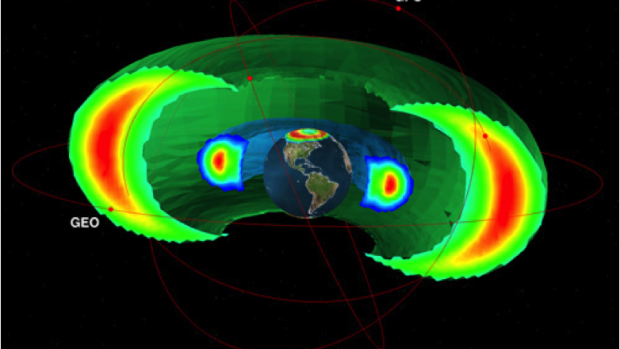
Radiation belts are regions of enhanced populations of energetic electrons and protons surrounding the Earth in space. These belts are highly dynamic, increasing and decreasing on time scales of minutes to years. The high levels of radiation caused by the energetic electrons and protons makes this a very harsh region for satellites.
Earth’s radiation belts, discovered shortly after the launch of the first US satellite in 1958, were one of the earliest discoveries of the space age. Since that time, while many satellites have made observations as they pass through the belts, much is still not understood about the processes that cause the energization, transport and loss of radiation belt particles.
There is a good understanding of the typical properties of the radiation belts, though, including their location and some of the processes that control the radiation belt intensity and variability. Radiation belt particle motion and dynamics are controlled to a great extent by the magnetic and electric fields in space and how these fields vary as a result of the interaction between the solar wind and the Earth’s magnetic and plasma environment. Electrons with typical energies above 0.1 Million electron volts (MeV) are found in both an inner belt (from about 1.5 to 3 Re (earth radii) above Earth’s center in the equatorial plane), and an outer belt (from about 3-10 Re). The so-called “slot region” forms between the two electron belts as a result of losses due to electron interactions with electromagnetic waves called whistlers. The radial location and intensity of the electron radiation belts are extremely variable, and predicting this variability is one of the major challenges for space weather forecasters. High-energy protons, with typical energies greater than 10 MeV, form one belt that extends from about 1.1 to 3 Earth radii.
The energetic particles that comprise the radiation belts can be hazardous for satellites and astronauts in space and can also have effects on Earth’s ionosphere and upper atmosphere. For example, high energy radiation belt protons, and even higher energy galactic cosmic rays, can alter the electronic state of sensitive electronic devices on satellites, resulting in computer errors or failures. In the case of high-energy electrons, they can cause serious damage to satellite cables and computer chips through a process called deep dielectric charging that culminates in harmful discharges. When MeV electrons precipitate into Earth’s upper atmosphere, they can deplete ozone and affect chemical processes in the atmosphere.
Image: R.V. Hilmer, Air Force Research Laboratory